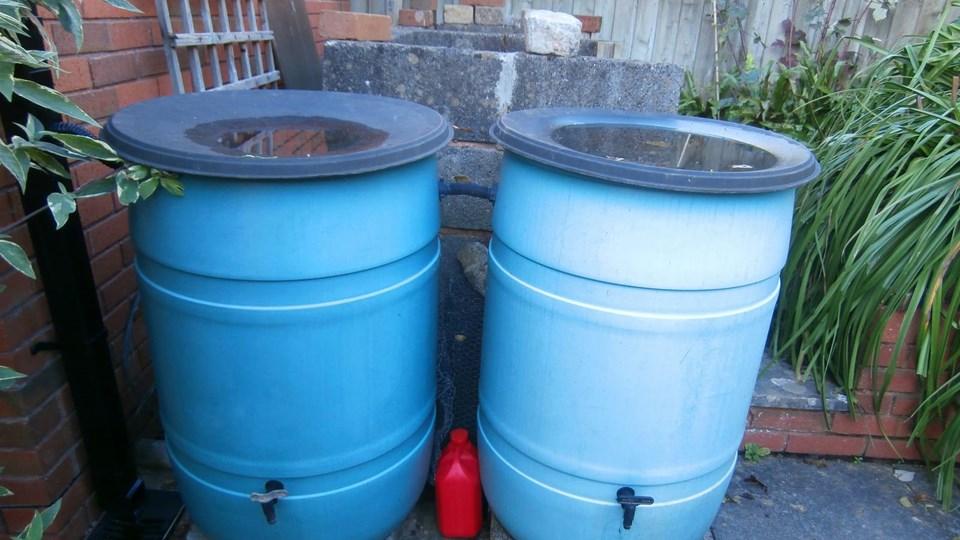Rain Barrels and Rainwater Tanks
A rain barrel (or rainwater tank) is a water tank used to collect and store rainwater. It maintains harvested rain—rainwater that gets reused before reaching the aquifer.

Such tanks can be used in any area and are commonly used to collect water from rooftops or rain gutters. Rain barrels are beneficial because they not only recycle water but also prevent excessive amounts of it from becoming stormwater and over-flooding areas.
According to the Environmental Protection Agency, lawn care and gardening make up as much as 40% of total residential summertime water use! Rain barrels can, therefore, be a huge benefit not only to people’s homes and gardens but their pocketbooks as well. By using a rain barrel, homeowners can save as much as 1,300 gallons of water during summer months¹. This harvested rain can be used outdoors for such purposes as lawn and garden watering, car washing, and swimming pool filling. It can also be used for toilets, washing machines, and—if it is properly filtered—even drinking water.
Components of a Rain Barrel
A rain barrel is a simple yet effective device that can be made of plastic, wood, ceramic, sandstone, or other materials. They range in size from 50 gallons to as much as 250 gallons and can be equipped with the following additions for greater efficiency:
- Rain Diverter: Directly connects a gutter or downspout to the top of a rain barrel, enabling more water to reach it while preventing debris and other objects from entering. Diverters can extend to one or multiple barrels and can have an automatic overflow feature, which redirects water to another barrel if the first fills up. This feature prevents over-spilling and water leakage.
- Connector Kit: Joins two barrels together. A connector hose can expand from three inches to six feet, allowing an attachment of almost any length in any area. Once the first rain barrel is filled, the connector kit will automatically transfer water to a second barrel. Such kits can easily be installed from the exterior and do not require any additional maintenance. Furthermore, they are equipped with various seal types to accommodate different rain barrel designs.
- Spigot: A spout found at the bottom of a rain barrel. Spigots have various flow rates, with some up to ten gallons per minute. Many are compatible with attachments for garden hoses, in-line pumps, soaker hoses, drip irrigation, or buckets.
- Spade Bit: A small drill bit used for drilling holes in rain barrels. These bits are unique because of their uncommon diameter (1 3/16”) and specific hole size they make for non-leaking, self-sealing barrel seals. Spade bits are sold at almost all hardware and garden supply stores and can also be bought online. Prices start as low as $3!
Cost
Rain barrels are affordable items and can be bought in multiple places. Hardware and garden supply stores sell them, while certain conservation programs even offer them at a reduced price as part of a financial incentive. For smaller, more simplistic purposes, homeowners can make their own rain barrels out of transport barrels, whiskey and wine barrels, or other similar products. This is a low-cost, sustainable alternative to purchasing a barrel.
Maintenance
- Position the barrel so that the overflow spout is directed away from the foundation of your home.
- Barrels must be sealed or covered with a fine screen to prevent mosquito breeding.
- Since rain barrels are exposed to the elements, they may deteriorate over time and need replacement or repair.
- Keep gutters and barrel covers free of debris that may impede water flow. The rain barrel itself should also be cleaned periodically.
- Disconnect and drain your rain barrel in the winter and store it upside-down. Repeated freezing and thawing of water in the barrel can weaken the material or cause cracks.
Advantages
Free Water
By using a rain barrel, you are able to collect rainwater at no cost for outdoor purposes such as lawn and garden watering, car washing, or swimming pool filling.
Runoff Reduction
Rain runoff tends to flow straight into main waterways such as rivers and canals. Along its path, rainwater can be contaminated by picking up soil, fertilizer, pesticides, oil, and other pollutants. By collecting and maintaining rainwater, overall runoff is reduced, and water pollution is minimized.
Healthier Plants and Soil
Using tap water to water gardens and lawns can actually harm plants due to the inorganic and fluoride compounds it contains. Rainwater, however, is a “soft water,” meaning it does not contain chlorine, lime, or calcium. Compared to tap water, rainwater is more beneficial to plant life and can positively change the overall look and health of your garden.
Organizations
PA Resources Council
UpstreamPGH
External Links
How to Build a Rain Barrel (PDF)
RainReserve
What is a Rain Barrel?
References
- Control Your Stormwater and Save Money, Use a Rain Barrel. (2010, June 24). The EPA Blog. https://blog.epa.gov/2010/06/24/control-your-stormwater-and-save-money-use-a-rain-barrel/
